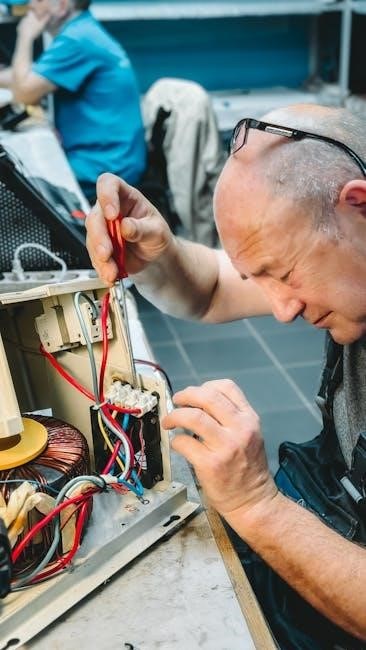Internal Family Systems (IFS) is a therapeutic model that views the mind as an ecosystem with a core Self and diverse parts. It aims to heal emotional wounds by transforming extreme roles of protective and vulnerable parts, fostering internal harmony and self-compassion.
1.1 Core Principles of IFS
Internal Family Systems (IFS) is rooted in the belief that the human mind is composed of multiple sub-personalities, or “parts,” each with distinct roles and responsibilities. These parts interact within an internal ecosystem, with a central, compassionate “Self” at the core. IFS posits that every part, no matter how extreme its behavior, has a positive intent, often aimed at protecting the individual from emotional pain. The model emphasizes non-judgmental understanding and empowerment, encouraging harmony among parts and fostering self-compassion. By addressing and transforming protective and vulnerable parts, IFS aims to restore balance and promote healing within the internal system.
1.2 The Concept of Self in IFS
The Self in IFS is the central, compassionate leader of the internal system, embodying qualities like curiosity, creativity, and confidence. It is the natural state of being when parts are unblended and in harmony. The Self is not a part but the essence of who one truly is, capable of leading and healing the system. IFS therapy aims to help the Self assume its rightful role, fostering clarity and connection among all parts. By accessing the Self, individuals can navigate their internal world with compassion and understanding, promoting healing and integration. The Self’s presence is key to restoring balance and well-being.
1.3 Goals of IFS Therapy
IFS therapy aims to liberate parts from extreme roles, allowing them to reclaim their natural functions. It seeks to heal emotional wounds by addressing and transforming protective and vulnerable parts. The therapy fosters internal harmony by helping the Self lead with compassion, promoting self-awareness and integration. By understanding and working with parts, individuals can reduce internal conflict and enhance their capacity for self-leadership. Ultimately, IFS therapy helps clients achieve emotional balance, personal growth, and a deeper connection to their true Self, leading to lasting healing and well-being. These goals are achieved through the Parts Mapping process and therapeutic exercises.
Understanding IFS Parts
IFS parts are sub-personalities within the internal ecosystem, each with distinct roles and emotional states, working together to compose the individual’s psychological landscape and functioning.
2.1 Definition and Roles of IFS Parts
IFS Parts are sub-personalities within the internal system, each holding specific roles, emotions, and beliefs. They interact dynamically, contributing to the individual’s psychological balance and behavior; Some parts protect the Self by managing emotions, while others carry unresolved wounds; These roles often manifest as either protective or vulnerable, influencing how individuals respond to life events. Understanding these roles is key to fostering communication and healing within the internal family system.
2.2 Primary Parts: The Inner Child and Beyond
The inner child is a primary part in IFS, representing the younger version of oneself that experienced life from birth to around age 21. This part holds memories, emotions, and beliefs from the past. There may be multiple inner child parts, such as the baby, toddler, or teenager, each with distinct needs and wounds. Beyond the inner child, other primary parts emerge, each with unique roles and perspectives. These parts contribute to the internal system, seeking balance and healing. Understanding and connecting with these primary parts is essential for fostering self-awareness and integration in IFS therapy.
The Parts Mapping Process
Parts Mapping is a structured exercise to identify and communicate with internal parts, using the 6Fs to explore their roles, feelings, and needs for healing and integration.
3.1 The 6Fs: A Step-by-Step Guide
The 6Fs in IFS Parts Mapping guide you through six steps to engage with your parts: Feel their presence, Find their location in the body, Flesh out their characteristics, Focus on their role, Find the Fear driving their actions, and Fix any misunderstandings. This structured approach helps clarify each part’s purpose, fostering understanding and healing.
3.2 Preparing for the Parts Mapping Exercise
Preparing for Parts Mapping involves setting clear intentions, creating a safe space, and fostering self-compassion. Ground yourself with mindfulness or deep breathing to enhance focus. Identify a specific issue or emotion to explore, ensuring clarity in your goals. Gather tools like a journal or worksheet to document insights. Approach with curiosity and openness, allowing parts to emerge naturally without judgment. This structured preparation enables effective communication with your internal ecosystem, promoting healing and understanding.
Types of IFS Parts
IFS categorizes parts into Managers, Exiles, and Firefighters. Managers protect, Exiles hold emotional wounds, and Firefighters react impulsively to prevent pain, each serving distinct roles.
4.1 Managers: The Protective Parts
Managers are protective parts in IFS that proactively guard against emotional pain by controlling behavior or emotions. They often take on roles like people-pleasing, perfectionism, or avoidance to prevent vulnerability. These parts are designed to keep Exiles (wounded parts) hidden and maintain a sense of safety. Managers can be rigid or inflexible, sometimes causing unintended harm by limiting authentic expression. Therapy aims to help Managers trust the Self and step back, allowing healing and integration of other parts. Understanding Managers is crucial for reducing their extreme roles and fostering internal balance.
4.2 Exiles: The Vulnerable Parts
Exiles are vulnerable parts in IFS that carry emotional pain, often stemming from past wounds or traumatic experiences. These parts hold negative beliefs and feelings, such as shame, fear, or sadness, and are typically isolated to prevent their pain from surfacing. Exiles are trapped in the past, reliving their wounds, and require compassion and understanding to heal. IFS therapy focuses on accessing and validating these parts, helping them release their burdens and reintegrate into the internal system. Healing Exiles fosters emotional relief and restores balance within the Self and other parts.
4.3 Firefighters: The Reactive Parts
Firefighters are reactive parts in IFS that activate to prevent emotional pain from surfacing. They intervene when Exiles’ wounds threaten to emerge, often by distracting or numbing the individual. These parts can manifest as impulsive behaviors, substance use, or intense emotions like anger or anxiety. Their goal is to protect the system by interrupting the pain, but their methods can sometimes cause harm or disrupt daily life. IFS therapy works to help Firefighters understand their role and find healthier ways to protect, allowing the system to heal without reliance on reactive strategies.

Benefits of Parts Mapping
Parts mapping promotes healing by transforming extreme roles of protective and vulnerable parts, fostering self-compassion and internal harmony through IFS therapy.
5.1 Healing Through Self-Understanding
Healing through self-understanding is a cornerstone of IFS therapy, enabling individuals to transform extreme roles of protective and vulnerable parts. By mapping and engaging with these parts, clients gain clarity into their internal dynamics, fostering empathy and compassion. The process involves identifying and communicating with parts, understanding their roles, and addressing their emotional wounds. This leads to the liberation of parts from burdens, allowing them to return to their natural states. Self-understanding becomes the foundation for healing, as individuals develop a deeper connection with their core Self, leading to lasting emotional and psychological transformation.
5.2 Cultivating Self-Compassion
Cultivating self-compassion is a powerful outcome of parts mapping in IFS therapy, allowing individuals to embrace their parts with kindness and understanding. By recognizing the roles and needs of each part, clients develop empathy and reduce self-judgment. This compassionate approach helps heal emotional wounds, fostering a supportive internal environment. Self-compassion becomes a tool for transforming protective and vulnerable parts, enabling them to release burdens and reclaim their natural states. Through this process, individuals build a nurturing relationship with themselves, promoting resilience, emotional balance, and a deeper connection to their core Self, leading to profound healing and personal growth.

Practical Tools and Techniques
The IFS Parts Mapping process offers practical tools to explore and understand internal systems. The 6Fs—Find, Focus, Feel, Fear, Fire, and Follow-up—provide a structured approach to engage with parts. Visual aids, like diagrams or worksheets, help map out parts and their roles. Setting clear intentions and goals enhances the exercise’s effectiveness. Techniques such as journaling, meditation, and guided imagery further support self-discovery. These tools empower individuals to navigate their internal ecosystem, fostering clarity and connection with their core Self, and promoting meaningful healing and growth through intentional engagement with their parts.
IFS Parts Mapping Workbook
The IFS Parts Mapping Workbook is a valuable resource for individuals and therapists to guide the exploration of internal systems. It provides structured exercises to identify and communicate with parts, using tools like diagrams and worksheets; The workbook includes prompts for reflection, helping users understand the roles and needs of their parts. By mapping emotions, beliefs, and physical sensations, individuals gain clarity on their internal dynamics. The workbook also offers space for tracking progress and integrating insights, making it a practical companion for self-discovery and healing. It empowers users to engage deeply with their parts, fostering personal growth and emotional balance.

Case Studies and Examples
Case studies illustrate the transformative power of IFS parts mapping in real-life scenarios. For instance, one individual used the workbook to identify a protective part causing procrastination, enabling them to address underlying fears. Another example involved a client who mapped parts related to childhood trauma, leading to emotional release and healing. These examples demonstrate how parts mapping helps individuals understand internal conflicts, fostering compassion and integration. By providing relatable stories, case studies bridge theory and practice, offering inspiration and practical insights for those engaging in IFS work. They highlight the diversity of experiences and the universal potential for growth through this approach.

Integrating Parts Mapping into Therapy
Integrating parts mapping into therapy enhances the therapeutic process by providing a structured approach to understanding internal dynamics. This method allows therapists to guide clients in identifying and communicating with their parts, fostering trust and self-compassion. By using parts mapping, therapists can help clients uncover underlying emotions and beliefs, promoting healing and integration. The non-pathologizing nature of IFS makes it a powerful tool for addressing trauma and fostering internal harmony. Practitioners often combine parts mapping with other IFS techniques to deepen the therapeutic experience, ensuring a comprehensive and empathetic approach to emotional healing and personal growth.
Advanced Techniques for Parts Mapping
Advanced techniques for parts mapping involve refining the process to deepen emotional healing and integration. These methods include working with multiple parts simultaneously, using visualization to enhance communication, and exploring the interplay between protective and vulnerable parts. Techniques like “unblending” and “reparenting” are employed to release parts from extreme roles. Additionally, advanced practitioners may integrate mindfulness and energy work to amplify the therapeutic impact. These techniques require a strong therapeutic alliance and a deep understanding of the IFS model, allowing clients to achieve profound emotional release and lasting harmony within their internal system.

